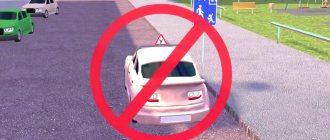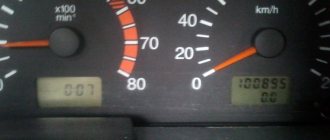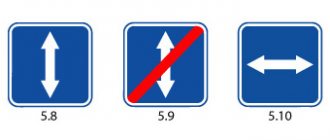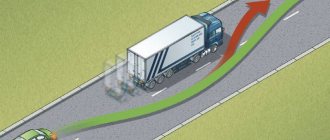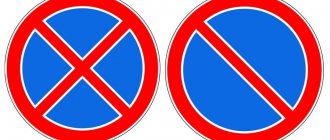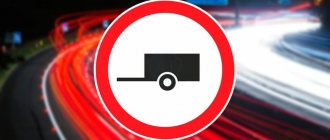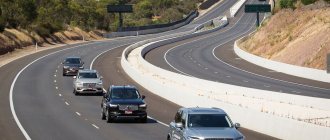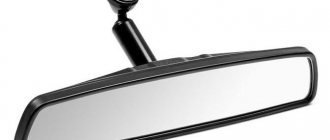Types of road markings
Highway lines are divided into two main categories:
- horizontal markings;
- vertical marking;
Let's consider each type separately.
Horizontal marking
This includes everything that is “drawn” on the asphalt. Such lines indicate the order of movement along this section of the roadway. Horizontal markings on the road are useful not only for car owners, but also for pedestrians.
To decipher the meaning of the lines, use the following table:
| Numbering in the rules | Applicability |
| 1.1 | "Solid." Used to create a boundary between two traffic flows in opposite directions. |
| 1.2 | Used to mark the edge on the roadway. For example, roadsides. Called "edge" |
| 1.3 | Drivers are familiar with this type of marking. They call it “double solid”. The purpose is the same as one. However, it is used on wider roads, for example, with 4-lane traffic. |
| 1.4 | Prohibits stopping on the selected section of the route. Apply to the edge of the road. |
| 1.5 | "Intermittent." Separates traffic flows, but allows overtaking or turning left. |
| 1.6 | The same intermittent one, but longer and notifies the car owner that he is approaching a “solid” one. |
| 1.7 | Indicates a lane in which you can move through an intersection. Simply put, this is a route map. |
| 1.8 | Such intermittent markings indicate separate rows intended for exiting the highway or braking. |
| 1.9 | It is used on roads where reverse traffic operates. |
| 1.10 | "Yellow dotted line." Also applied to the edge of the road. It does not prohibit stopping, but parking in this place will be prohibited. |
| 1.11 | Allows any lane changes, advances and even turns, but only on the side on which the intermittent one is located. |
| 1.12 | Refers to a boundary used to stop before an intersection, pedestrian crossing or railway crossing. |
| 1.13 | The “Triangle” marking on the road indicates that you need to give way on this section of the road. As a rule, there are several triangles |
| 1.14.1, 1.14.2 | Designations of various types of pedestrian crossings. |
| 1.15 | Such markings inform the driver that the road is crossed by a path intended for bicycle traffic. |
| 1.16.1–1.16.3 | Safety islands for pedestrians who did not have time to cross the road. |
| 1.17 | Informs the driver that minibuses stop at this location. |
| 1.18 | Show directions of movement along the lanes. |
| 1.19 | Indicates a narrowing of the road. The direction of the arrow indicates in which direction the roadway will narrow. |
| 1.20 | Warns you when approaching an intersection where you will have to give way. |
| 1.21 | Warning markings indicating that you are approaching a marking marked “STOP”. |
| 1.22 | These numbers indicate the route number. |
| 1.23.1 | The letter “A” indicates a lane for minibuses and buses. "Bus Lane". |
| 1.23.2 | Footpath. |
| 1.23.3 | Bike path coverage area. |
| 1.25 | Placed in areas with low traffic speeds or in front of a pedestrian crossing. In the rules, such markings are prescribed as “artificial unevenness”. |
| 1.26 | "Waffle iron" If there is a traffic jam at the intersection, then you cannot drive into the waffle iron. |
There are certain types of horizontal markings that are not used in all cities. Eg:
- 24.7 – looks like a rectangle and the letter D. Allows parking only for diplomatic vehicles.
- 24.3 – designates parking spaces allocated for disabled people of any group.
- 24.5 – only electric vehicles may park or move in this location.
All other types of markings only duplicate road signs.
Vertical marking
This type of marking according to traffic regulations is used exclusively on vertical surfaces and structures. It indicates areas of dangerous structures and structures so that the driver can visually navigate and correctly direct the vehicle. There are few types of such markings.
| Numbering according to the rules | Where is it used? |
| 2.1.1–2.1.3 | Such markings can indicate structures, for example, supports of bridges and tunnels, which can create a danger for drivers. The direction of the lines indicates the detour direction. Similar markings can be applied to temporary road signs that are installed in the middle of two lanes. |
| 2.2 | Also shows the boundaries of the bridge and tunnel, but from above. Necessary for truck owners who know the dimensions of the vehicle. |
| 2.3 | Boundary lines that indicate safe zones on expressways and highways. |
| 2.4 | Denotes various street lamps or poles. |
| 2.5 | It is used on bump stops to mark the edge of the road before dangerous areas, for example, cliffs. Currently, it is completely replaced by reflective elements. |
| 2.6 | Necessary for marking the side parts of various dangerous structures. |
| 2.7 | Sometimes islands are created on roads, raised above the road. It is for such structures that this type of vertical marking is used. |
If a highway passes under a bridge or overpass, the upper part of which, as well as the supports, are not marked with vertical markings, then this structure is placed in violation of safety standards. The road authorities are responsible for this. This is GOST.
Yellow markings
It is important to differentiate between yellow and orange markings, as they mean completely different things. For example, yellow markings indicate the following:
- Prohibition on stopping or parking. As mentioned earlier, a yellow single solid line along the roadway prohibits stopping at the indicated location. And intermittent does not prohibit stopping, but introduces a ban on parking.
- Places and sections of the road intended for stopping route vehicles. As a rule, it is made in the form of a zigzag. Does not prohibit ordinary drivers from stopping, but on the condition that they do not create any interference for buses.
Orange markings
This type of lines on the road is temporary. That is, its effect will not be permanent. As a rule, orange markings are applied on those sections of roads where repairs are being made. To do this, it’s worth considering a trivial example:
The road surface was cut off on a section of the road. The new one will not be installed soon, so new orange markings are quickly being made for car owners. Where it was intermittent will now become continuous.
Temporary markings always take precedence over permanent markings. Therefore, even if both types of lines are available at the same time, drivers should rely on the orange ones. However, this type of line is rarely present with white markings. And even if this happened, the situation can be considered as a violation on the part of the road services.
Practical examples
Now let's look at those situations that most often cause conflict between elements such as road signs and markings. This will allow you to understand in what situations how to act in order not to violate traffic rules.
One of the most striking examples in which you need to remember that the most important sign or marking is the unacceptable combination of a double continuous dividing strip (in the traffic rules it comes with the position designation 1.3) and a temporary turn here sign (position in the modern edition of the traffic rules 4.2.2 ). Moreover, the sign indicates precisely that it is necessary to cross this double solid road. In such a situation, a higher rank has a temporary sign and it is necessary to strictly focus on it. Otherwise, an emergency situation on the road with an unfavorable outcome is possible.
Also, new signs have been added to the existing traffic rules
Another example is when a “overtaking is prohibited” sign is installed (position 3.20 in the rules) and horizontal intermittent markings are applied (position in traffic rules 1.5). On the one hand, the pattern on the road does not prohibit driving into the oncoming lane. But the sign prohibits this action; you cannot overtake. But it is possible to drive out in order to go around an obstacle (for example, a broken down car or a hole dug on the highway) or to make a left turn. At the same time, no sanctions should be taken against you by traffic police inspectors. Since avoiding an obstacle does not create an emergency situation on the road. Another nuance associated with the sign of poses. 3.20, which you need to know about, is that the section of the road to which it applies is not regulated. In accordance with the modern edition of the rules, it ceases to be valid after the emergency period ends. But when this section ends, you need to navigate using other signs. The simplest option is if, in conjunction with sign 3.20, another “end of the no-overtaking zone” is installed with position 3.21. Another option is to install special information signs, which will regulate the segment in which overtaking vehicles will be prohibited.
Below we give another example. There is a sign “End of the no-overtaking zone” (in the rules its number is 3.21) and a solid horizontal stripe (its number according to traffic regulations is 1.1). In this case, the markings prohibit entering the oncoming lane. And the sign only shows the end of the no-overtaking zone. It shows, but does not mean, that you can overtake. And drivers should know and understand this. Therefore, you can only drive in your own lane. In this situation, the marking has a higher priority than the sign. The sign only shows the end of a certain section of the highway where overtaking is prohibited. And the markings regulate the possibility of movement along this segment. When you try to overtake, you can run into a traffic police patrol and in such a situation you can be legally deprived of your license. Such overtaking creates a situation on the road with a high accident rate.
conclusions
In normal situations on the road, road signs and markings complement each other perfectly. But if a non-standard environment is created that goes beyond the permissible, then they may contradict each other, at first glance
Here it is important to understand what is more important in each specific situation. Nothing else but knowledge can resolve this situation.
https://avtomotospec.ru
What has priority – road signs or markings on the asphalt?
Many car owners are interested in what they should do when dealing with contradictions on the road? For example, there is a road sign on the road prohibiting overtaking, but the line in the middle is broken.
The traffic rules say that in any case, the road sign will have priority. Moreover, if the markings are temporary, but the road sign is permanent, then this is a violation of road services. With orange markings, appropriate signs must be used.
Controversies and examples
To present the information more clearly, let’s look at some examples with controversial issues.
Overtaking at 3.20 signs and broken lines
If an element prohibiting overtaking is installed on the road and a horizontal marking of 1.5 is applied, such a case must be considered as follows:
- The sign prevents overtaking.
- A broken line does not prohibit entry into the adjacent lane.
Together, these two indicators indicate permission to enter oncoming traffic during any action other than overtaking. It is possible to drive around in the oncoming lane, turn left, or make a U-turn.
IMPORTANT! The broken line is considered to allow overtaking. This opinion is wrong
In the presence of one, it is not allowed to go beyond the edges of the strip.
Innovations in traffic rules that are in force in 2021 assume the priority of any road signs over any markings
Overtaking with symbol 3.2.1 and solid line
As you know, 3.21 means “End of the no-overtaking zone.” In such a case:
- A solid one is a ban on any driving into oncoming traffic (including when overtaking other vehicles).
- The first sign does not allow overtaking, but only indicates the end of the prohibited zone.
This rule is incomprehensible to many motorists who start overtaking across a continuous road and lose their license.
Avoiding repairs on the road in the oncoming lane
If there is a “Double solid” marking on the road surface and the sign “Detour on the left” is set, the designations here contradict, because on the side, it is prohibited to cross the double solid line, and on the other side, the sign “Detour on the left” allows crossing the markings.
The sign remains important in this combination, so driving in the oncoming lane is a legal phenomenon.
Video about markings and signs
The article discusses amendments to the traffic rules on temporary and permanent designations, as well as examples that help when contradictions arise on the roads. Now the question regarding road signs should not lead to a dead end.
What's the difference between one and two solid ones?
Many car owners are interested in what is the difference between these two markings. On some sections of roads they use one solid road, and on others, even double ones. There is an explanation for this.
- Double solid is used on roads that have several lanes for traffic in one direction. However, this rule is not the only one. Not only the number of stripes determines the appearance of a solid line. If the width from the edge of the roadway to the middle is more than 3.75 meters, then such a road will have a double continuous road.
- One solid one is used in places where this width is smaller or where one lane is used for one-way traffic.
Such types of markings not only delimit sections of roads, but also introduce restrictions on overtaking, ahead, changing lanes, turning left or making a U-turn. For such violations there are very strict penalties, including deprivation of rights.
Temporary signs and markings
The main difference between temporary road signs and permanent ones is the yellow background. Moreover, it can be applied both inside the sign and on the surface surrounding it. Both of these options are equivalent and are equally present on the roads in certain cases that determine the need to change the usual traffic pattern. Until 2013, this type of signs was placed on portable stands, but now this requirement does not exist, and they can be installed, like permanent ones, on vertical supports. As for the markup, here color will also become the main indicating parameter. Temporary is done with orange paint, regular - white. Thus, in the issue of primacy, there are four groups of requirements, which are dictated by permanent or short-term markings, stationary signs or signs installed for a certain period.
Fines for violations of road markings
If you do not obey the requirements of road markings, you may receive a fine. Its size and degree of punishment depend on the severity of such a violation. The list of penalties is as follows:
- Driving along the median strip. Only special and operational vehicles can enter it, however, as in any other conditions. The fine for such a violation is 500 rubles.
- Row-related disorders. In simple terms, this is a banal violation of the rules of maneuvering. For example, at an intersection there is a stripe indicating the place of passage. If you don’t drive along it, you can run into a fine of 500-1500 rubles. In exceptional cases, a traffic police inspector may punish the driver with a simple warning.
- Intersection of a solid line. This violation is gross, and therefore the punishment will be appropriate. For the first time, the driver faces a fine of 5,000 rubles. But for systematic violations, he may lose his license for 4-6 months. Moreover, if the offense was recorded not by a police officer, but by a camera, then they will only be punished with a fine. However, there are mitigations. For example, if there is an obstacle on the road, then driving around a solid road will not be such a serious violation. For this, the driver will be fined 1,500 rubles.
- Waffle iron. If a driver enters this marking when there is a traffic jam there, he will face a fine of 1,000 rubles. The exception is when turning right. In this case, the punishment for the driver will apply only after stopping.
- STOP line. If a driver stops behind a line designated for stopping before an intersection, he will face a fine of 800 rubles.
